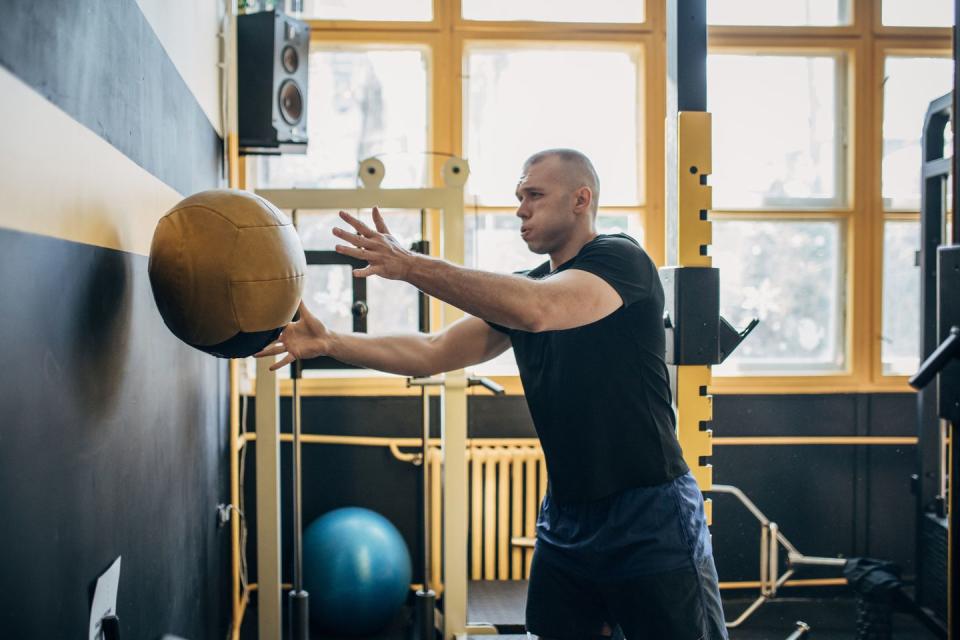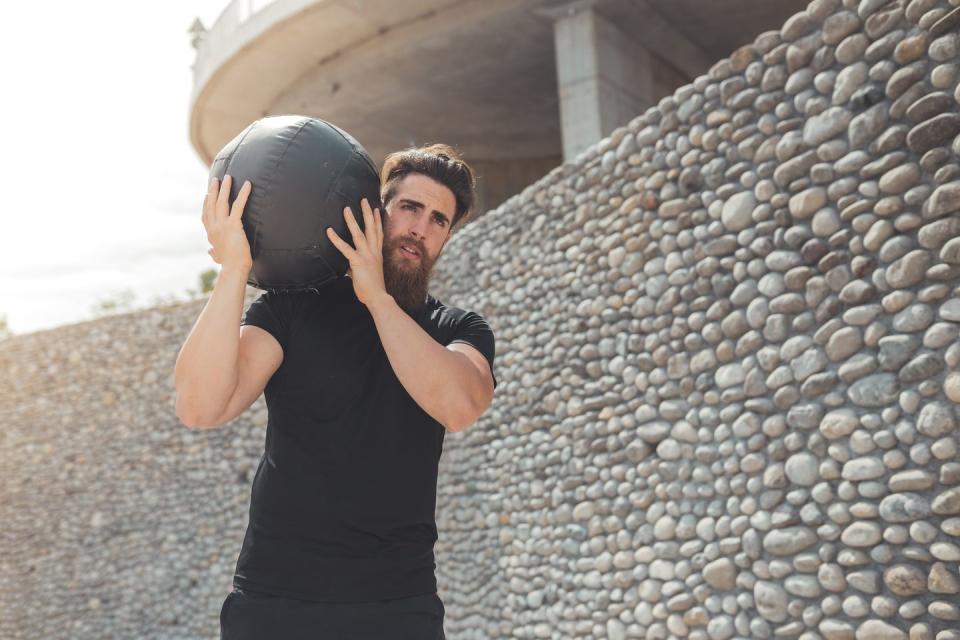How You Should Use Medicine Balls In Your Workouts

THERE ARE FEW MORE potent feelings in the gym than grabbing a heavy load, lifting it over your head, and then using all of the power you can muster to throw it down into the ground. You'll not only blow off steam and (make a satisfyingly resounding slam)—you'll also be honing your power, strength, and even muscle as you do it. But you can't just toss around any type of weight. You'll need an implement that can provide enough heft to challenge yourself and hit the ground without bouncing back up into your face or damaging the flooring. Dumbbells and kettlebells won't do that. Medicine balls do.
Medicine balls, the round, weighted orbs designed to be hefted tossed, slammed, thrown, and rolled, are a staple of functional fitness workouts and activities like CrossFit, where exercises like wall balls are commonplace. But all kinds of exercisers can use these versatile tools for their workouts to add an athletic or plyometric throwing component to your training. Med balls can be a great implement for training indoors (if your gym has enough space to throw them), and they're even more useful outdoors, where you'll have more room to really let fly.
There's more to med ball training than just tossing the ball back and forth. Before you add the implement to your workouts, you should take the time to understand how you'll get the most benefit out of the types exercises you'll be doing. The ways that med ball training demand you to move your body to create force are complex and challenging for your biomechanics.
Benefits of Medicine Ball Workouts
Versatile
You can train anywhere
Build power, strength, and cardio endurance
There are a wide range of applications for medicine ball training
You can hone rotational power, tap into full-body output, work end-range strength in extended positions, or do stability work. Even better, you can get out of the gym easily. A med ball works just as well against the wall in your gym as it does against a wall outdoors, making this a great option to train anywhere.
Here’s the thing with most pieces of equipment in the gym: You can use them one way for each motion, with little room for variability. It’s hard to make subtle changes to the way you initially load, say, a dumbbell biceps curl. That can limit the variation in the training program.
Med balls aren’t like that; they're extremely versatile. They adjust to what I call “footprint” and “handprint”. By footprint, I mean your stance. You can change the space between your feet as you set up to throw a med ball, or stagger the feet (a split stance) or keep them parallel to each other (bilateral stance). That change lead to adjustments in how your core, glutes, and shoulders must act on the med ball.
Handprint is hand positioning, which alters the force potential and torque that other joints apply to the med ball. Grip a med ball with both hands in similar positions, for example, and you’ll likely have to finish each throw with your shoulders square. That’s very different from the way you’d finish each med ball throw if you gripped the med ball more like a basketball, with one hand behind it and one hand along its side. Explore these different positions, depending on your training goals.
How You Can Use a Medicine Ball to Train For Power

Explosive moves are a great way to tap your body’s power potential. It’s easy to brush off power training and think you don’t need it, but power training is more relevant for everyone than you think.
To build a well-rounded body, your training should be a mix of what you need to do everyday and what you need to do on occasion. Even if you’re not tapping the power you build in power training daily, the explosive strength you build helps in even the smallest tasks, delivering just a little bit of bounce even when you walk.
Training your power has plenty of virtues. It can preserve tissue integrity, improve joint health, and hone your basic ability to move. And med balls allow you to do that.
Medicine Ball Training in Different Planes of Movement
Most fitness training theory includes a discussion of planes. Your body can move in three planes. There’s the sagittal, which is essentially when you move directly forward. Movements like walking and front raises occur in the sagittal plane. There’s also the frontal plane, which essentially occurs when you’re moving laterally. Lateral shoulder raises are a movement in the frontal plane.
Finally, there’s the transverse plane, which essentially encompasses twisting motions. Imagine cutting your body in two, and having your hips turn in one direction and your upper body in another. That twisting motion occurs in the transverse plane.

Many traditional gym exercises occur in one plane, but med ball movements are unique in that they’re multi-planar. You’ll get to move in multiple planes, with some parts of your body moving sagittally, some moving in the transverse plane, and some moving in the frontal plane, all in one motion. That’s real life—and it prepares you for real life, too.
Biggest Medicine Ball Training Mistakes
It’s easy to get into a habit of doing med ball work for only metabolic gain and piling up tons of reps to spike your heart rate. This has benefit in enhancing your work capacity, but don’t let it be the only way you use med balls.
When you pile up those reps, your explosive ability in the workout gradually diminishes and you fail to truly train power. Spend some time using med balls for shorter, more explosive sets to get the most out of them.
Also, think about which type of ball you're using to do which exercise, and where you're doing them. Some medicine balls are made with rubber or rubber-like material. That's fine for lots of throwing movements, especially if you're working on partner exercises—but it makes them poor candidates for slams directly into the floor or wall due to the risk of a rebound directly into your face. You'd be better off with a slam ball, which are often made from leather-like material or softer rubber to dull the rebound upon impact, for that type of exercise.
The Best Medicine Ball Exercises
Add these med ball exercises into your routine, or do them as a full workout. However you do them, don’t always think about reps. Instead spend some time working for only short bursts of time. Your goal on every rep is to be as explosive as possible, and working for too long will lead you to compromise form and waste each rep.
Think of doing each move for three to four minutes, working for 20 to 25 seconds, then resting for the rest of the minute.
Rotational Med Ball Throw

Why: One of the key functions of your core is to rotate your torso, and this exercise will teach you to do that explosively. It does so in a way that’s natural to your body, involving your hips and glutes as well.
How to Do It:
Stand with your side a few feet from a wall, holding a med ball. Your feet should be in athletic stance.
Rotate your shoulders away from the wall (your hips may rotate too), then explosively rotate toward the wall. Release the ball into the wall as fast and powerfully as you can. It should bounce.
Pick it up, reset, and begin another throw.
Work for 6 to 8 minutes, switching sides every set.
Med Ball Slam
Why: Athletes frequently train something called triple-extension, the idea of straightening (or extending) at the hips, knees, and ankles all at once. This contributes to upwards explosive moves like jumps and, to some extent, faster running. The opposite of triple-extension is something called triple-flexion, bending at the knees, hips, and ankles all at once. You’ll train both triple-extension and triple-flexion with the med ball slam, while revving up your heart rate and stimulating your abs, too.
How to Do It:
Stand with your feet a little wider than shoulder-width apart, knees bent, a med ball held in both hands.
Explosively raise up onto your tiptoes, lifting the med ball high and throwing your arms over your shoulders. (You should be in triple-extension now.)
Now explosively bend your knees and hips and throw the ball straight at the ground.
Catch it on the bounce, reset, and begin another rep.
Med Ball Chop

Why: This is another great core exercise that’ll hit your abs and obliques and force you to do so in a natural, explosive way. It also incorporates coordination, getting you moving from a high position to a low one.
How to Do It:
Start in athletic stance, with a med ball over your right shoulder, arms extended.
Breathe in. Then exhale and “chop” the ball across your body and downwards toward your left knee; let your torso and hips rotate as you do this. Be explosive as you do this; your knees and hips will rotate.
Return to the start position and repeat.
Rainbow Slam
Why: This move will fire up your legs, glutes and core, and it’s another great example of triple-flexion, challenging you to explosive bend at the hips, knees, and ankles all at once while blending in a rotational component. It’s a great way to build coordination. The workout below incorporates rainbow slams and crushes your core.
How to Do It:
Start with the med ball on the ground near your right foot. You should be in athletic stance, feet slightly wider than shoulder-width apart, knees bent.
Keeping your feet facing forward, grasp the med ball with both hands; your torso will have to rotate for this to happen.
Explosively lift the med ball overhead, standing onto your toes (triple-extension). Your torso will rotate as this happens.
Continue that rotation and the movement and explosively throw the ball into the ground near your left foot.
That’s 1 rep; grab the ball on a bounce (or off the ground) and rainbow slam the ball onto the other side.
The Med Ball Burner Workout
Give this med ball workout routine from trainer Mat Forzaglia a try to blast your abs and learn some different ways to use the implement.
The Warmup
Perform 10 reps of each exercise for each round. Take no rest.
Round 1
Ground to Overhead Press
Toe Taps
Russian Twists
Round 2
Ground to Overhead Press
Toe Taps
Russian Twists
Round 3
Ground to Overhead Press
Toe Taps
Russian Twists
The Workout
Perform each exercise for as many reps as possible in 30 seconds. You'll do 3 exercises in a row with no break, then rest for 30 seconds.
Circuit 1, Round 1
Alternating Slams
Reverse Lunge with Rotation
Table Top Situps
Circuit 1, Round 2
Alternating Slams
Reverse Lunge with Rotation
Table Top Situps
Final Circuit
Perform each exercise for 2 reps, then 4 reps, then 6 reps, then continue adding 2 up the ladder until you hit 3 minutes of work.
Overhead Slam
Med Ball (or Jump) Squat
Mountain Climber
You Might Also Like